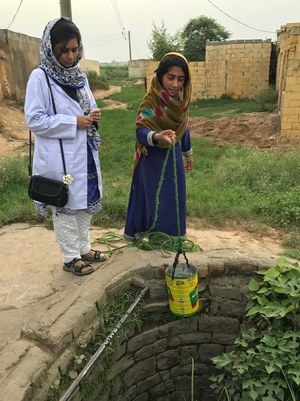
A new study from Eawag Aquatic Research in Switzerland reveals that many groundwater wells in the Indus Basin are showing levels of arsenic concentration as high as 200-500 µg/L, though WHO considers 10 µg /L to be the safe limit.
Groundwater supplies in Pakistan are essential to over 50 million people living in the densely populated plains along the Indus River. Data from 1200 groundwater samples were used to create a hazard map of the region, revealing for the first time the regional health risk that the population is exposed to. There is emerging evidence suggesting that this is exacerbated by irrigation.
One of the most common contaminants found in drinking water around the world, arsenic is a natural component of alluvial sediments. Small quantities are naturally dissolved in groundwater, and despite being tasteless and odorless, it’s highly toxic. Long-term ingestion, even in low concentrations, is linked to skin conditions, liver disorders, cardiovascular and kidney function issues, and often cancer. According to the World Health Organization (WHO), around 150 million people worldwide rely on arsenic-contaminated groundwater.

Collection of samples from a dug well in the Gujrat district of Punjab province (Photos: Tasawar Khanam, COMSATS)
Processes of dissolution vary depending on hydrologic and geologic conditions of the sediments and aquifers. “Concentrations of dissolved arsenic are known to be particularly high in fluvial sediments with abundant organic material and limited oxygen supplies, e.g. in the deltas of the Ganges (Bangladesh) or the Red River (Vietnam),” Eawag explained in a press release. In these locations, arsenic bound to iron oxides is released due to the chemically reducing environment.
Pakistan does not have this same reducing environment, however, and the new study has a hypothesis as to why this anomaly is present. Evaporation of irrigation water from both surface and groundwater stores could potentially increase the pH of the soil, thus increasing the solubility of arsenic from the sediments. When water infiltrates alkaline topsoil and sediment, arsenic is released into shallow groundwater supplies. This is supported by a strong correlation between high soil pH and elevated arsenic levels, which also coincide with heavily irrigated areas.
The researchers at Eawag used a model that correlates soil, hydrological, geological and topographical parameters with occurrence of arsenic to create a map that shows the probability of high arsenic contamination throughout Pakistan.

Fig. 3. Arsenic risk mapping (A) Probability (hazard) map of the occurrence of arsenic concentrations in groundwater exceeding the WHO As guideline of 10 mg/L along with the aggregated arsenic data points used in the modeling (n = 743). (B) Density of population at risk of high levels of arsenic in groundwater using the WHO As guideline of 10 mg/L. Figure was based on 2016 population figures and a 60 to 70% groundwater utilization rate. The estimated number of people potentially affected is ~50 million to 60 million, with hotspots around Lahore and Hyderabad.
Joel Podgorski, first author, recommends urgent testing of all drinking water wells in the Indus Plain. Furthermore, the relationship between intensive irrigation, high arsenic concentration and high soil pH should be investigated further. In regions where contamination is already dangerously high, water should be sought from arsenic-free aquifers or processed for arsenic removal.










































